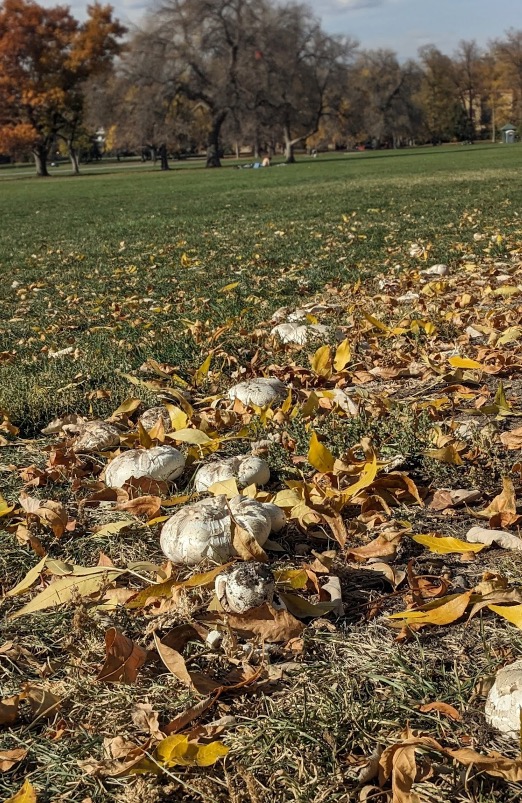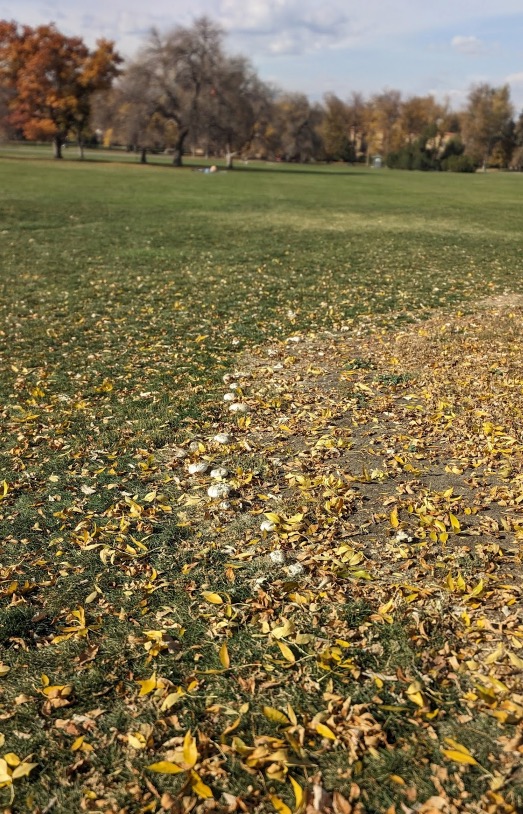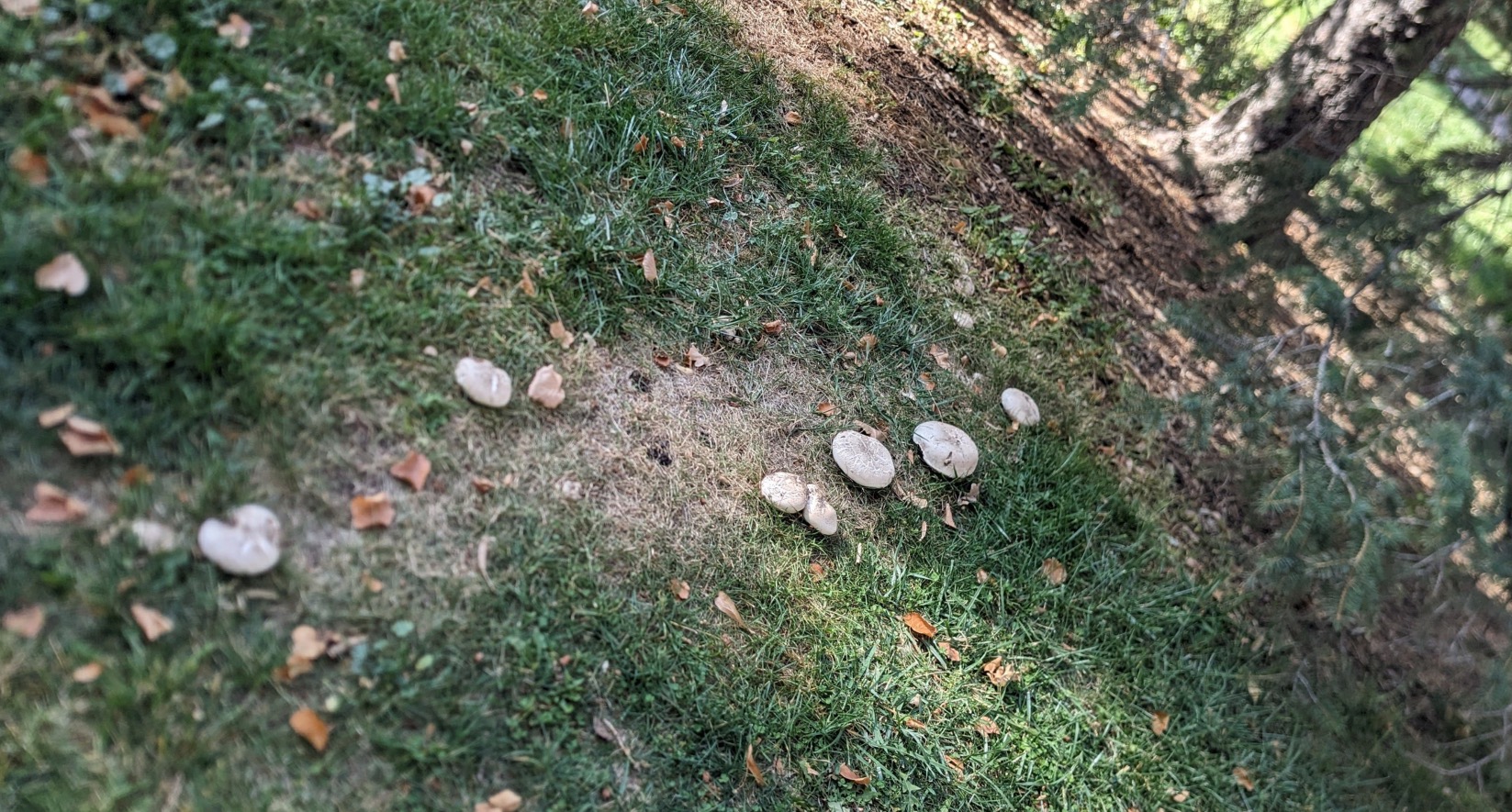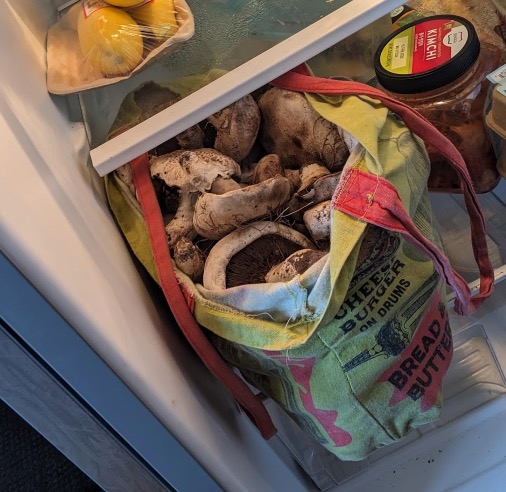On Foraging Mushrooms at Cheesman Park
Article Table of Contents
- Introduction
- Agaricus Bisporus
- 🍄 from the park vs the grocery store
- Where in the park to find them
- Mushrooms and fungal networks are cool
- Fat is cool, too
- Foraged mushrooms vs capitalism
- Foraging Mushrooms respectfully
- Long-term storage
- Mushrooms and amino acids
- How to prep & eat mushrooms, deliciously
- Additional Reading
- Footnotes
Introduction #
I live quite close to this park in Denver, Cheesman Park. Last year, I wrote something about accessing the Botanic Gardens from Cheesman.
A few months later I updated it, noting that I’d found mushrooms in the park and began feeding them to the fish.
I also regularly am in the park doing these barefoot hill sprint things
The koi fish obviously love the mushrooms, I’ve fed them to the fish dozens of times, now.
< todo: add a photo or video of the koi busily eating mushrooms >
As I spent more attention on the mushrooms, I got some books about mushrooms identification, from the botanic gardens library, so I could positivity identify whatever kind of mushroom this was with more confidence than the seek app + me looking at photos of things online.
Agaricus Bisporus #
turns out it’s not too difficult to classify mushrooms. It’s a bit of a flow chart one works through. I learned to positively identify these mushrooms, as well as the two kinds of mushrooms responsible for 100% of fatal mushroom ingestions.
It helps to be able to easily observe the mushroom across all stages of development. I made my first spore prints.
This mushroom variety is known as ‘the common mushroom’, agaricus bisporis (wikipedia). It’s the most commonly consumed mushrooms in the world also the same as what you could buy in the grocery store. The common mushroom! I love common things. Common things and abundant things often go hand in hand.
Here’s some of what the page on wikipedia says:
It is cultivated in more than 70 countries and is one of the most commonly and widely consumed mushrooms in the world. It has two color states while immature – white and brown – both of which have various names, with additional names for the mature state, such as chestnut, portobello, portabellini, button, cremini, and champignon de Paris.
🍄 from the park vs the grocery store #
Since that moment over a year ago, I’ve fully replaced my mushroom purchasing from grocery stores with mushrooms chosen from Cheesman park, and it’s been a persistent source of interestingness, and a quality-of-life improvement across many dimensions.
I pass by the park far more frequently than I go to a grocery store, and I pass through the park on my way to other places, on my scooter, all the time, and I can, with a glance from my scooter as I ride by, check different spots I’ve seen mushrooms growing, or a quick walk about. There’s almost always many, many more findable mushrooms than I could ever pick, even on the days that I’ve picked 35 pounds of mushrooms.
Getting mushrooms from the park sort of reminds me of the experience of having a corner store that sells produce, right around the corner from wherever I’m living, and I can dash inside and get vegetables for dinner that night or the next day, any time of day and night, as I’m walking home.
This experience is common in so many cities around the world, but is ‘banned’ in america because supremacists got their way and still do. 1
I have been willing but unhappy to be giving money to capitalism, especially the kind of capitalism of king soopers and trader joes and sprouts. A corner, neighborhood grocer, I’d prefer to give my money too.
with this park discovery, however, I now have something with the convenience of a veggie stand a half block away, yet it doesn’t even allow for money to be transacted, and it’s open 24 hours a day, and does not require anyone else to labor under capitalism for me to use!
No one is forced to run a checkout machine, no electronic devices are used to collect money. There is no scale involved. (I have a tindek progressor scale for climbing training, and can use it to weigh the bags of mushrooms, but it’s not supporting capitalism!)
I’ve certainly become much more attentive to how the grass and dirt feels under my toes, the presence of moisture, the temperatures that I notice, when walking around the park, too. Less capitalism and more nature and walking barefoot in wet grass? Yes please. I am still using it for my barefoot hill sprints
Where in the park to find them #
The mushrooms grow in very reasonable patterns throughout the park. Often they grow on the edges of root balls, the root balls of long-dead cedar trees, where not even a stump remains. My mental model is that a certain kind of mycelial network is metabolizing the roots, and as it metabolizes, when the water is abundant and conditions are right it sorta takes a breath, and exhales a flush of mushrooms.
They might develop for 3 days, eventually open up and drop spores, and then fade back into the grass. Any time they’re above ground, as long as they’ve not gotten stepped on or smashed or dried out, they could be good for the plucking and eating.
It can go from ‘no mushrooms are visible anywhere’ to ‘wow that is a lot of mushrooms’ overnight.

some people call the patterns in the grass, left by these underground root balls ‘fairy circles’. They’re sometimes faint, sometimes quite distinct. This is exactly where the mushrooms seem to like growing.

This single blob of mushrooms might be 3 lbs of mushrooms, maybe more:

The abundance is distinctive.
I have made mushrooms an intentional, specifically sought out part of my diet for years. Now I don’t even pay for them, and I eat even more of them than I did before.
Sometimes at the park I pick just a few handfuls of mushrooms, enough for me to add to my meals regularly for a few days. Some single mushrooms are so big that I will eat only half of it with my next meal.
Sometimes I’ve collected many more mushrooms than I could eat in just a few days, and I suspect mushrooms are unlikely to grow year-round, so I baked them down in the oven at 350 degrees for a while, then vacuum sealed them and stored them in the freezer.
I have already been surprised by how late into the year the mushrooms continue to grow and the mycelial networks continue to fruit. (It’s currently almost November, and I picked a kilo of mushrooms a few minutes ago, I’ll eat them later today, two days ago I filled a reusable grocery bag, it was like 12 lbs of mushrooms)

Mushrooms and fungal networks are cool #
I’ve been a huge fan of mushrooms for many years, but it was only a few days ago that I learned after encountering this document, that mushrooms technically contain all of the essential amino acids, just some sort of amino acid that cannot be manufactured within the body.
The documentary fantastic fungi has tons of beautiful time laps photography/videography of fruiting fungal networks.
The book Entangled Life: How Fungi Make Our Worlds, Change Our Minds & Shape Our Futures is worth snagging at a library, too.
something feels particularly right about at least a few bites of mushroom in with the egg and veggies that I eat every day.
Fat is cool, too #
Seems worth mentioning that I also make sure to be eating what feels like an adequate amount of fat, in the form of olive oil and coconut oil.
I spoon a tablespoon or 2 of coconut oil into meals as I sauté them, often enough, or add coconut cream (stored in the freezer if I don’t use it all) to some dishes, and virtually always pour 10-20 grams of olive oil (a few table spoons) on every meal I have.
Sidebar on fermented food #
this piece is turning into being about more than just mushrooms, so sorry
I also would advocate for kimchi, sourkrout or kombucha. any sort of fermented food. I make my own kombucha, so at least every few days will have at least a few sips of kombucha. I imagine nice things happening in my gut when I do that. I don’t think more than a tablespoon or two is needed for a full dose of active culture of whatever is being fermented. So, i try to get at least a little fermented food with most meals. I have a friend that gets me costco kimchi containers, and i’ll make one last for a while. I will make my own kimchi someday. I love fermented food of all types, and appreciate what my gut bacteria do for me. I try to be a reasonable enough host for that collection of bacteria.
Fat is the main portion of the structure of our a brain such as ours, as well as the spinal cord. Fat also can be metabolized by the liver for energy generation stuff, same same but different as sugar can be metabolized for energy. 2
Foraged mushrooms vs capitalism #
Anyway… Mushrooms now compromise a meaningful amount of my food consumption, and it’s been over a year since I’ve bought mushrooms.
I didn’t get into this with the intent of decapitalizing any my food consumption, and I note now having done so it feels satisfying. In the same way that hunting an animal might engender a sense of accomplishment, or raising plants in a garden might spark accomplishment, finding mushrooms in the park feels appealing. I had nothing to do with any part of the process besides showing up and plucking the mushroom, and there isn’t even time invested. This is vastly preferable to all forms of gardening I’ve ever encountered in my life, until now.
I dislike capitalism, and would like to see dramatically less of the human experienced affected by the intrusion of currency, money, into the human experience3
I’d love to see infinite food available for all. I don’t believe in political authority, but if there WAS a case for political authority, it would look like ‘using resources to cafe for those in need’, and providing food to anyone who wanted it checks the book. I wish no other bombs or cars were ever allowed to be created again until everyone in the USA, maybe in the world, who wanted food, had it, for free, no obligations or dehumanizations involved, and american cities were covered again with streetcars, trams, rail transport. Such is my fantasy.
Foraging Mushrooms respectfully #
I dislike capitalism, and I dislike colonialism, slavery, and genocide, and all of those things are sorta opposed to healthy relationships (between us and ourselves, us and each other, us and the land we live on top of and travel across).
Robin Wall Kimmerer wrote this article: ‘the honorable harvest’.
I’ve read many books, but never Braiding Sweetgrass: Indigenous Wisdom, Scientific Knowledge, and the Teachings of Plants, also by by Robin Wall Kimmerer. I’m listening to the audiobook right now, and it’s a delight.
Foraging has sometimes been a less-than-innocuous activity when it comes to issues of political power, but it’s also the activity that quite directly encourages a certain respectful relationship between people and nature. It’s a stark contrast to agriculture, which is synonymous with the State and its armies and slave labor.
For some fascinating takes on the state and the people living beyond the state, and foraging and the many other forms of how life existed outside the strictures of agriculture & the state, I suggest James C Scott. I just finished The Art of Not Being Governed: An Anarchist History of Upland Southeast Asia and found it to be exceptional. (It’s nominally an examination of state formation and un-formation in a region centering on modern-day thailand.) It deserves its own blog post. 4
Long-term storage #
I’ve also only recently made some big improvements in how I prep the results of this foraging.
Sometimes I’ve collected far more than I can eat in a few days.
< as I type these words I have a ten pound bag of mushrooms in my fridge waiting for prep - add the photo >
- Bake mushrooms whole
- Pan fry whole too
- Treat like steaks - crispy on the outside, seasoned, v uniform and juicy on the inside. Different energy than chopping them up, prior way I prepped all mushrooms.
< insert photo of using torch to sear outsides of the mushrooms >
They seem to bake and do even better in the fridge with this treatment, which makes sense.
When they’re growing in the earth, and maintain their shape and structure, they grow successfully, but if smushed or cut or kicked or they already dropped spores and are thus expired, some other stuff, depending on the stage of development, different sorts of failure set in. An undisturbed, normally-growing mycilial network fruiting body is a neat capsule that retains mosture and structure with a pretty distinctive outermost shell that’s a bit flexible and rigid at the same time.
So far I believe mushrooms have been spotted in the park surprisingly many months of the year. Through November for sure, and it was sometime this last spring I spotted them for the first time this season.
I have noticed that I spend less at the grocery store; I no longer buy mushrooms, which per-pound are sorta expensive, and since it’s abundant and free to me, I have shifted my regular veggie mix (a rotation of broccoli, zucchini, squash, cauliflower, cabbage, asparagus, brussel sprouts…) more towards mushrooms.
I mostly don’t eat meat5, and low-key I wish more did the same. I dislike enslavement and forced/coerced suffering. Chattel slavery was some shit, in the American south, that energy continues today and something in the meat industry too willingly embraces enslavement in so many directions. I stopped eating meat in 2017 after reading Eating Animals. I’ve tried to reduce the amount of enslavement and suffering my eating habits rely upon. If you are what you eat, I wonder what I am. I eat almost exclusively mushrooms, eggs, cruciferous veggies, olive oil and coconut oil.
Now that mushrooms are available abundantly, for free, three blocks from my house, well, my meat consumption continues to stay at almost 0, and my mushroom spending is 0, but my mushroom consumption has gone up, nicely.
Mushrooms and amino acids #
I didn’t know until quite recently that mushrooms seem to contain all essential amino acids (and maybe the non-essential ones, too). I didn’t know that. I’ve been wanting to reduce my egg consumption, so when I heard this my ears perked up, and I’m sorta playing with reducing egg consumption. I’ve done some days where I eat only two eggs, so far so good. 6
How to prep & eat mushrooms, deliciously #
No one likes to feel dirt or sand in their teeth, so give the mushrooms a good scrub in water. Maybe two scrubs. Trim the stem where it connected to the mycilial network, to remove the dirt embedded there. Or, scrub it all off. Or trim it, sorta making the shape of the tip of a pencil, to remove the dirt from that part of the mushroom. Rinse it with water again.
I’d been cooking and eating these mushrooms for almost a year before I ever ate one raw. The thought had never crossed my mind. Then it did, and I was immediately brought back, taste-wise, to the experience of eating salads with raw mushrooms on them. Familiar and normal. Now I eat these (after rinsing them) raw, regularly, and I don’t know why I didn’t start long ago.
They are fine raw, but finer with some olive oil and salt. Usually I’d chop and sauté them, and they go great with onions, garlic, ginger. maybe some broccoli or zucchini. once everything is soft add some eggs, and drizzle some olive oil when plating. It’s delicious.
They can be sliced up before cooking, but my most recent innovation has been to not slice them up before cooking! I’ve been pleased with the results. Sometimes I’ll slice them up after cooking, like a little fillet.
I’ve recently started cooking them whole, it’s been great:

I’ll probably add more to this post soon. I was noticing big improvements in the cooking part of the mushrooms, and lamented that I’d not even created a single page about them on this website, even though so much of my actual, day-to-day life has been affected, improved, by this encounter.
I’ve told many people about this, in person, but still have not yet encountered a single other person foraging mushrooms for their own use. I hope to someday meet someone else, or many others, doing just this.
I’ve found these mushrooms growing in other parks, too. I don’t know other parks like I know cheesman, but I’ve sometimes spotted some. Maybe explore around wherever you live. I’ll maybe update this if I find other parks with abundant quantities of mushrooms growing in them, especially if agaricus bisporus.
Additional Reading #
- Nutritional Quality and Biological Application of Mushroom Protein as a Novel Protein Alternative
- Entangled Life: How Fungi Make Our Worlds, Change Our Minds & Shape Our Futures
- Yunnan people are currently obsessed with one thing: mushroom foraging in the mountains…【滇西小哥】 (I watched this video a few times when cleaning and prepping my foraged mushrooms)
- Eating Animals, Jonathan Foer
- Braiding Sweetgrass: Indigenous Wisdom, Scientific Knowledge, and the Teachings of Plants by Robin Wall Kimmerer
- The Honorable Harvest (Robin Wall Kimmerer)
- Anything by James C Scott
Footnotes #
-
This thing we could call ‘american-style zoning’, or ‘euclidean zoning’, ‘segregated land use zoning’, whatever. The original designation for R1 neighborhoods was in a section titled ‘race zoning’:
r1 - wh*te, r2 - c*lored. Here’s the link to the whole thing, and the goal was sorta to create enclaves, reservation-type conditions, and segregate a city by the fantasy of race. They pushed all economic activity to the ‘edge’ of the enclave. not just are R1 neighborhoods tremendously bad, but the very concept of separating commercial from residential space and use is rooted in this energy to dominate others. It’s why the united states has lost the ‘cultural technology’ of the corner store, a corner store.This pamphlet trying to hype the concept of zoning was written by people who loved the enslavement of others at scale. The mayor of Atlanta! I’m bummed to see so many people tirelessly working on replicating his kinky fantasy of a world separated by race, created by a violent and stupid person, small groups of likeminded people. ↩
-
The comparisons and contrasts between ingested sugar-based things (any food that is an
-ose, like sucrose, glucose, fructose, lactose) as energy and ingested fatty things as energy is riveting. I wrote a thing about wearing a continuous glucose monitor. The experiences and observations from that monitor continue to be some of the more interesting and impactful-in-an-ongoing-way of my life. Sorta like psychedelics, or an experience of the numinous. I walked away from the experience with an increased gratitude and appreciation for what my own body did for me, when it comes to energy generation, digestion, energy storage, response to exercise, etc. managing blood sugar levels, raising it when exercising, lowering it via insulin or activity if I ate carby stuff. ↩ -
I sometimes entertain the idea in my mind of starting a little ‘forage mushrooms from cheesman park’ group. When it’s producing mushrooms, hundreds of pounds of mushrooms can be found in the park. Could represent meaningful money savings from some people. Many, many people could be fed. ↩
-
i do technically eat some meat. it’s been almost a decade since I’ve eaten cows, pigs, or chickens, and I wish those industries were dramatically reduced, or eliminated. Native people ate bison, i say stop growing corn and turn all the land back to native people and bison herds. Ending concentrated animal feeding operations/slaughterhouses would be so cool.
95% of my meat consumption is the occasional consumption of sardines and salmon. Even then, I eat these much less than weekly. At restaurants, I might order something with shrimp (the other 5%). Otherwise, a vegetarian dish for me.
before 2017 I ate lots of cows, pigs, chickens, then read eating animals, and stopped all meat consumption. I do eat and have always have eaten a lot of eggs, and sorta wish I ate less. Not even none, but have not yet found my way to low egg consumption. I eat at least three a day, maybe closer to 4 or 5 sometimes. I don’t drink milk, I sometimes eat cheese, certainly sometimes eat ice cream, and a little heavy cream is sometimes tasty in the coffee. I do not avoid butter. ↩
-
I still don’t quite know what an amino acid is. Why is there exactly 22 of them for human animals? can existing amino acids be reused or recycled? My mental model was always that my body can mostly fabricate the amino acids it needs, and the stuff it cannot, it’ll scavenge it from the environment or the self (reusing, recycling). My mental model of a cell is not that it ever spontaneously falls apart and washes away, but that the structural elements can be taken apart and re-used. Like taking down a brick wall, moving the bricks, and re-building the wall. I also happen to view eggs as a source of everything the body could need, so if I needed external sources of compounds or molecules, I’d get it in eggs. I don’t begrudge my body at all if it decided to take down some tissue to reuse the components elsewhere. autophagy is cool, I theorize that I might get more of it than some people, because my protein consumption is not so high, + the occasional intermittent fasting vibe. ↩